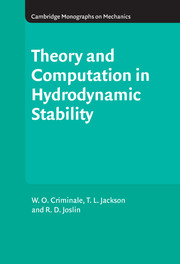Book contents
- Frontmatter
- Contents
- Figures
- Tables
- Preface
- 1 Introduction and problem formulation
- 2 Temporal stability of inviscid incompressible flows
- 3 Temporal stability of viscous incompressible flows
- 4 Spatial stability of incompressible flows
- 5 Stability of compressible flows
- 6 Centrifugal stability
- 7 Geophysical flow
- 8 Transient dynamics
- 9 Nonlinear stability
- 10 Transition and receptivity
- 11 Direct numerical simulation
- 12 Flow control and optimization
- 13 Investigating hydrodynamic instabilities with experiments
- References
- Author index
- General index
10 - Transition and receptivity
Published online by Cambridge University Press: 06 July 2010
- Frontmatter
- Contents
- Figures
- Tables
- Preface
- 1 Introduction and problem formulation
- 2 Temporal stability of inviscid incompressible flows
- 3 Temporal stability of viscous incompressible flows
- 4 Spatial stability of incompressible flows
- 5 Stability of compressible flows
- 6 Centrifugal stability
- 7 Geophysical flow
- 8 Transient dynamics
- 9 Nonlinear stability
- 10 Transition and receptivity
- 11 Direct numerical simulation
- 12 Flow control and optimization
- 13 Investigating hydrodynamic instabilities with experiments
- References
- Author index
- General index
Summary
Introduction
In this chapter, we discuss the breakdown of hydrodynamic instability, a theory that is initially characterized by a system of linear equations, as discussed in great detail in Chapters 2–8. Breakdown thus implies that the linear assumption is becoming invalid and the flow now has several modes interacting and amplifying. This interaction can then transfer energy to modes not yet dominant in the flow. The culmination of this breakdown process is a turbulent flow. One might suppose that the characteristics of the breakdown stage depends on the initial conditions – as receptivity – as well as freestream conditions such as vorticity and freestream turbulence. Today, we understand much about this initial stage and the linear amplification stage but have only limited knowledge for the nonlinear processes of many flows (cf. Chapter 9) because the complete Navier-Stokes equations must be solved and tracing measurements in this stage back to their origin to ascertain the cause and effect is challenging.
The major goal of this text has been to present the subject of hydrodynamic instability processes for many different engineering problems. The initial chapters demonstrated that this understanding can most often be achieved with linear systems. However, as was somewhat evident in Chapters 8 and 9, the transition from a laminar to turbulent flow is extremely complicated. This Chapter and the next will expose the reader to issues effecting hydrodynamic instabilities, the nonlinear breakdown of modes after linear growth, and we will summarize a condensed history of methods that have been used to predict loss of laminar flow and onset of transition to turbulence.
- Type
- Chapter
- Information
- Theory and Computation of Hydrodynamic Stability , pp. 291 - 319Publisher: Cambridge University PressPrint publication year: 2003



